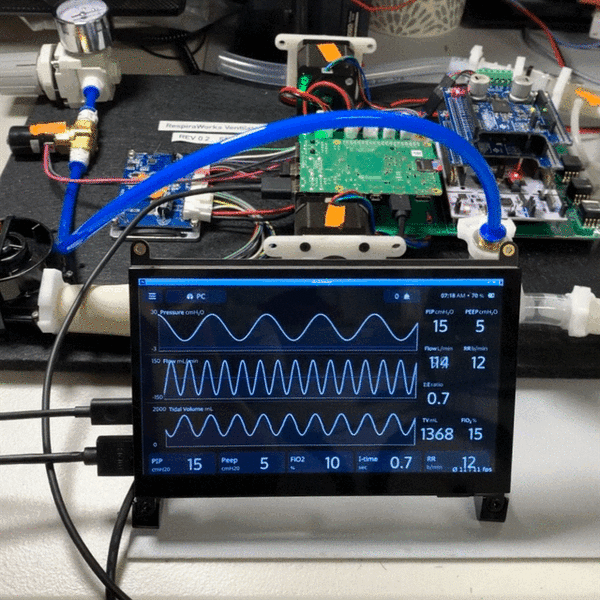
Top 10 Finalists in COVID-19 Design Innovation Grant
We were named one of the top 10 finalists for the COVID-19 Design Innovation Grant out of hundreds of submissions! The International Design Awards (IDA), in collaboration with the European Product Design Awards, created this grant to support those working to provide innovative solutions to the pandemic. Congratulations to the other finalists and to the winner of the challenge, David Bassetti! For a list of the finalists and their projects, visit the IDA’s COVID-19 Design Innovation Grant website.
We submitted our application for the CoVent-19 Challenge
Last night RespiraWorks reached a major milestone by completing and submitting our application to the CoVent-19 Challenge. In there are countless hours of design, simulation, testing, 3D modeling, video editing, and reporting. Check out the assembly demonstration for prototype ventilator model we compiled for CoVent-19 Challenge.

GUI is a-go
The GUI is written and up on the PI, running on the prototype hardware! Thank you to our incredible team of engineers for their hard work.
Working Demo: Triple Actuator Control
This is a working demo of triple actuator control with the exhale pinch valve, the inhale pinch valve, and the oxygen proportional solenoid, all able to be controlled simultaneously from our code. We now have the ability to control both ambient air as a pressure source and pressurized oxygen as a pressure source from a single controller. This video shows an example of switching between oxygen control and the blower as an input pressure source (ambient air) within the same code.
Life Leader Testing
Now that our design has matured, it’s time to start thinking about how long things will last. The idea behind life leader testing is to always have one set of hardware that has been running longer than any other hardware in the field or on the bench, so if something breaks, it breaks there first. We're running this 24 hours a day to test the longevity of the parts we think are most likely to have a limited lifetime, which are the pinch valve and the blower. Soon we'll start performing life leader testing with a complete ventilator unit.
Pressure Response Rate
One of the major issues that we have been working on in the ventilator design is achieving the required pressure response rate to support high PIP to PEEP pressure swings at high respiratory rates. When we built the Alpha prototype, we found that we could meet one requirement or the other, but not both at the same time, using only the blower speed for pressure control.
In response to this issue, one of our volunteer engineers developed this fast-moving stepper-driven pinch valve to be paired with the blower. It is shown here performing the closed-loop pressure control function, driven by our new Ventilator Mainboard. Here the setup is delivering a 2cmH2O to 35cm pressure cycle at 20 breaths per minute, and you can see how quickly this system can deliver the commanded pressure to the test lung.
There is still a lot of work to do, but our dedicated volunteers are making progress every day to get us closer to having a working product.

More hardware!
We are hard at work to get hardware into the hands of our dedicated dev team. Now six more ventilator mainboards have been completed and will be shipped out once they have undergone functional testing.

RespiraWorks awarded $50,000 grant from CITRIS!
We are so excited to announce that RespiraWorks has just received a $50,000 grant from CITRIS and the Banatao Institute! We will be applying the fund towards equipment and labor in building our low-cost open source full feature ventilator.
The Center for Information Technology Research in the Interest of Society (CITRIS) and the Banatao Institute create information technology solutions for society’s most pressing challenges. CITRIS was created in 2001 as one of four interdisciplinary institutes for science and innovation at the University of California by the California state legislature to shorten the pipeline between world-class laboratory research and the development of applications, platforms, companies, and even new industries.
Page 3 of 6 pages